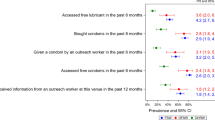Abstract
We investigated whether female condoms are acceptable to sex workers in Harare and whether improved access to male and female condoms increases the proportion of protected sex episodes with clients and boyfriends. Sex workers were randomly placed in groups to receive either male and female condoms (group A, n=99) or male condoms only (group B, n=50) and were followed prospectively for about 3 months each. We found a considerable burden of human immunodeficiency virus (HIV) and sexually transmitted infections (STIs) in our cohort at enrollment (86% tested HIV positive and 34% had at least one STI). Consistent male condom use with clients increased from 0% to 52% in group A and from 0% to 82% in group B between enrollment and first follow-up 2 weeks later and remained high throughout the study. Few women in group A reported using female condoms with clients consistently (3%–9%), and use of either condom was less common with boyfriends than with clients throughout the study (8%–39%) for different study groups, visits, and types of condom). Unprotected sex still took place, as evidenced by an STI incidence of 16 episodes per 100 woman-months of follow-up. Our questionnaire data indicated high self-reported acceptability of female condoms, but focus group discussions revealed that a main obstacle to female condom use was client distrust of unfamiliar methods. This study shows that a simple intervention of improving access to condoms can lead to more protected sex episodes between sex workers and clients. However, more work is needed to help sex workers achieve safer sex in noncommercial relationships.
Similar content being viewed by others
References
Joint United Nations Programme on HIV/AIDS. Report on the Global HIV/AIDS Epidemic Geneva, Switzerland: Joint United Nations Programme on HIV/AIDS; 2000.
Heise LL, Elias C. Transforming AIDS prevention to meet women's needs: a focus on developing countries. Soc Sci Med. 1995;40:931–943.
Stein Z. HIV prevention: the need for methods women can use. Am J Public Health. 1990;80:460–462.
World Health Organization. The Female Condom, A Review. Geneva, Switzerland: World Health Organization; 1997.
Sato PA, Maskill WJ, Tamashiro H, Heymann DL. Strategies for laboratory HIV testing: an examination of alternative approaches not requiring Western Blot. Bull World Health Organ. 1994;72:129–134.
Fontanet AL, Saba J, Chandelying V, et al.. Protection against sexually transmitted diseases by granting sex workers in Thailand the choice of using the male or female condom: results from a randomized controlled trial. AIDS. 1998;12:1851–1859.
Simonsen JN, Plummer FA, Ngugi E, et al. HIV infection among lower socio-economic strata prostitutes in Nairobi. AIDS. 1990;4:139–144.
Laga M, Manoka A, Kivuvu M, et al. Non-ulcerative sexually transmitted diseases as risk factors for HIV-1 transmission in women: results from a cohort study. AIDS. 1993; 7:95–102.
Taha TET, Canner JK, Chiphangwi JD, et al. Reported condom use is not associated with incidence of sexually transmitted diseases in Malawi. AIDS. 1996;10:207–212.
Weir SS, Feldblum PJ, Roddy RE, Zekeng L. Gonorrhea as a risk factor for HIV acquisition. AIDS. 1994;8:1605–1608.
Allen S, Serafilira A, Bogaerts J, et al. Confidential HIV testing and condom promotion in Africa. JAMA. 1992;268:3338–3343.
Allen S, Tice J, Van de Perre P, et al. Effect of serotesting with counselling on condom use and seroconversion among HIV discordant couples in Africa. Br Med J. 1992;304:1605–1609.
Richters J. Researching condoms: the laboratory and the bedroom. Reprod Health Matters. 1994;3:55–62.
Browne J, Minichiello V. The condom: why more people don't put it on. Soc Health Illness. 1994;16:229–251.
Civic D, Wilson D. Dry sex in Zimbabwe and implications for condom use. Soc Sci Med. 1996;42:91–98.
Musaba E, Morrison CS, Sunkutu MR, Wong EL. Long-term use of the female condom among couples at high risk of human immunodeficiency virus infection in Zambia. Sex Transm Dis. 1998;25:260–264.
Ngugi EN, Wilson D, Sebstad J, Plummer FA, Moses S. Focused peer mediated educational programmes among female sex-workers to reduce sexually transmitted disease and HIV transmission in Kenya and Zimbabwe. J Infect Dis. 1996;174(suppl 2):S240-S247.
Author information
Authors and Affiliations
Corresponding author
Rights and permissions
About this article
Cite this article
Ray, S., Wijgert, J.v.d., Mason, P. et al. Constraints faced by sex workers in use of female and male condoms for safer sex in urban Zimbabwe. J Urban Health 78, 581–592 (2001). https://doi.org/10.1093/jurban/78.4.581
Issue Date:
DOI: https://doi.org/10.1093/jurban/78.4.581




